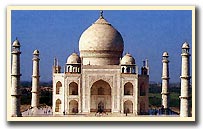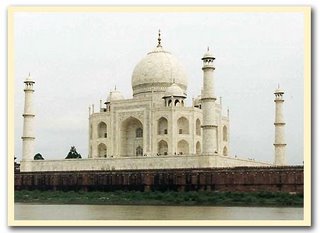Building of Taj Mahal
Besides the miraculous architectural features and the elaborate ornamentation of the Taj Mahal, many additional features, which can often be overlooked, help complement and enhance this spectacular monument.
Background
Unlike other Mughal tombs, the garden of the Taj Mahal has been laid out entirely in front of the tomb and does not play any part in the 'background'. Instead, the background has been provided by the sky. This background is not constant; it changes its colour and texture more than often, and the Taj is always presented in a variety of tints and moods. Its shades are subtly reflected on the white marble surface of the Taj Mahal which changes its colour and complexion accordingly.
Marble
The Makrana marble used is of such a nature that it takes on incredibly subtle variations of tint and tone, according to the changes in the light, thus picturing the passing colour of the moment.
Soaring Effect
The colossal height of the tomb, along with its pyramidal appearance (which is obtained by the receding plinths, the square tomb and the bulbous dome, along with the pilasters surmounted by pinnacles, the tapering minarets and the decreasing volume of the dome culminating in a kalasa) give it a soaring effect. It appears as if it is about to rise into the sky...an ethereal quality full of lightness and grace.
Correction of Illusionary Effects
Taj Mahal, Agra TourismThe indigenous builders of the Taj Mahal fully understood the deceptive nature of the human eye. They knew that the reality and its perception and interpretation thereof differed. The plinth of the main tomb is 2'10'' high on an average. But the height varies at different places, particularly the central point between two piers being in each case 0.5" to 0.7" higher than the sides. This convexity has deliberately been given to the plinth in the centre of each arch, or else the building would have appeared as if it were falling down! The facades are not exactly at a right angle with the plinth, but are slightly inclined.
The finial is a stupendous crowning feature which measures nearly 10 meters!! The architect fully anticipated the apparent size which a finial would present from such a great height. It has therefore been very ingeniously been planned. These features of construction demonstrate the ability of the Indian architects to reconcile the illusionary effects created by distance and light.
Inside The Taj Mahal
The interior of the mausoleum comprises a lofty central chamber, a crypt immediately below this and four octagonal corner rooms originally intended to house the graves of other royal family members.
In the centre are the cenotaphs of Shah Jahan and Mumtaz Mahal. Shah Jahan's cenotaph is to the left and is higher than that of his beloved which rests immediately below the dome.
The cenotaph of Mumtaz Mahal stands in the centre of the marble screen, it has inscribed on it in Persian with texts from the Koran. The cenotaph of Mumtaz has the single epitaph inscribed on it- "Marqad Munavvar Arjumand Bano Begum Mukhatib bah Mumtaz Mahal Tanifiyat fer sanh 1040 Hijri" (Here lies Arjumand Bano Begum called Mumtaz Mahal who di((d in 1040 A.H. or 1630 A.D.)
The cenotaph of Shah Jahan is inscribed in Persian- .'Marqad Mutahar Aali Hazrat Firdaus Ashiyani Sahib-qiran Saani Shah Jahan Badshah taab surah sanh 1076 Hijri" (The sacred sepulchre of his most exalted Majesty, dweller of Paradise, the second lord of constellations, the king Shah Jahan, may his mausoleum ever flourish, 1076 A.H. (1666 A.D.).
Inside The Taj Mahal, Agra Travel Above the tombs is a Cairene lamp, the flame of which is supposed to never burn out.
Marble screen of trelliswork surrounds the graves. Both tombs are exquisitely inlaid with semiprecious stones.
The acoustics of the building are superb with the domed ceiling being designed to echo chants from Koran and musician's melodies.
It is suggested that one walk around the outside of the tomb, before retrieving your shoes, to appreciate it from all sides.
Taj Mahal Story
The story of Taj Mahal reflects the intensity of love. The fairy tale began when walking through the bazaar of Agra prince qhurram saw a girl. The girl was exceptionally beautiful. It was a love at first sight for both of them. After five years, on an auspicious day they were married and from that moment began the great epic of love.
Shah Jahan, "The King Of The World"
Prince qhurram was the fifth son of emperor Jahangir. He was the man of extraordinary brilliance, a great diplomat, a warrior and a lover of art. Once Jahangir wrote, "In art, in reason, in battle there is no comparison between him and my other children". In the honor of his numerous victories Jahangir entitled him as "Shah Jahan", "The King of the World". After Jahangir's death all his sons quarreled for the thrown, after fighting for years Shah Jahan killed all his brothers under suspicious circumstances and became the emperor, besides him stood his queen, comrade and confidante.
Mumtaz Mahal "The chosen one of the palace"
Shah Jahan titled her "Mumtaz Mahal", "The chosen one of the palace". A rare found combination of beauty and brain. She was her husband's best friend and confidante. She would counsel him in the diplomatic matters. She too was a great lover of art.
The End of the Fairy Tale
Shah Jahan & Mumtaz MahalIn 1631 Shah Jahan set up to berahanpur with his troops to subdue a rebellion, accompanied by Mumtaz Mahal Unfortunately during childbirth she suffered some complications and died. According to legend before dieing she extracted a promise from Shah Jahan that he would build a mausoleum as a tribute to their love.
The story of Taj Mahal begins Shah Jahan was obsessed to fulfill his wife's last wish. He invited the architects and artisans all over the world and planned for the building with absolute perfection. Taj Mahal was structured in Persian style combined with carvings of artisans called from Afghanistan and the garden designers from Kashmir. It took 22years to complete the Taj Mahal, a memento of love with the perfection of art. The carvings of Taj Mahal were decorated with very precious gemstones.
The story of Taj Mahal is unique in itself. It is an evidence that how the emotions and feelings are important to human life. The story of Taj Mahal is an example of devotion and faith. The story of Taj Mahal is a love story not found in papers but stands in the structural form. The story of Taj Mahal is rare.
The beauty of Taj








Saturday, August 26, 2006
Some facts about Taj Mahal
Posted by Lijin at 4:14 PM
Subscribe to:
Post Comments (Atom)
Blog Archive
-
▼
2006
(38)
-
▼
August
(15)
- Onnashamsakal :)
- Microsoft has using an open-sourse software for it...
- More about our Onam
- Pesticide Percentage (%) in cool drinks !!!
- The TEN days of Onam
- Onam : The National festival of Kerala
- Some facts about Taj Mahal
- Some rare pictures from the computer world
- Light Field Camera- An article from "Science Daily"
- Flexy Flex from Adobe
- Latest Developments in the .Net World
- The new attractive features of JDBC 4.0
- Ban on Coke and Pepsi in Kerala
- Leopard : The new challenge from apple to Vista
- Microsoft may discount Vista
-
▼
August
(15)
Based on original Visionary template by Justin Tadlock
Visionary Reloaded theme by Blogger Templates



0 comments:
Post a Comment